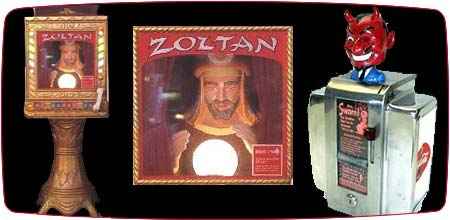Fortune Telling Machines

Retro Coin Op Synopsis
Don’t go thinking these old booths are just quaint relics of arcade lore. After all, Tom Hanks was granted a wish-come-true from a fictional Zoltar Speaks booth in the movie Big, so clearly, the games still have some magic juice in them even today. Think of it: a wish for a quarter…it has to be the greatest coin-op bargain of all time.
Fortune-telling machines started to appear in arcades during the 1930’s, and those were years that dropping coins into game slots seemed like the last thing people would be doing with their money. But actually, if a person had a spare penny or two (and on the way home from the newsstand or the grocery, he frequently did), the arcades were a cheap, temporary way to put your real-world problems on the backburner.
The fortune machines were simple: the Mystic Pen, for instance, wrote out a “special” fortune for a player after he inserted a penny. And Exhibit Supply’s An Answer from Beyond had players ask pertinent questions (like, “Will I Marry a Blonde?”) and then glean answers from a picture of the all-knowing Egyptian mummy Ramasees, located just inside the cabinet.
A few years later, arcades saw the coming of more elaborate fortune-telling booths, and in terms of coin-op artistry, these might just have taken the cake. Inside the beautifully finished wood cabinets, set behind glass and usually seen from the chest up, there were mannequin “tellers” that weren’t just life-sized, they were also incredibly life-like. If you were going to pay cold hard cash for something as dubious as a randomly distributed fortune, at least someone who looked the part was doing the distributing!
The tellers were frequently costume-jewelry-and-fancy-robe-wearing women, but sometimes these booths had models of bearded men and animals dipping their toes in the pool of prediction, too. The tellers were shown to nod, breathe, blink, and finger mystic objects like tarot cards and tealeaves. And if a teller had a name like “Grandma”…well, who wouldn’t believe the little prediction cards that she doled out? Later fortune telling games had zodiac options—a player twisted the knob to his particular sign—for “added accuracy” (which is, of course, not to say that they weren’t accurate in the first place).
Many of the games built around this time were assembled with parts taken from pre-war arcade games, because in the war years, new parts for non-essential mechanical items couldn’t be obtained. In post-war years, the 50’s and 60’s especially, old-fashioned arcade games came back into vogue and were widely manufactured. There were still mannequins, but they tended not to be as finely detailed as they were in years past. Sometimes just the idea of a fortune-teller was compelling enough. A shiny metal “Swami” napkin holder, for instance, was eerily used in the “Nick of Time” Twilight Zone episode, dispensing a whole lot more than just napkins to its diner patron, played by a young William Shatner.
One of the most memorable players on the fortuneteller block during the 70’s was Bacchus’ Madame Morgana. Here, a woman’s face was projected onto a blank, head-shaped screen, from whence she started to move and talk, and promptly dispensed a player’s fate. When this disembodied favorite did her thing, it looked as if she was speaking, and looking, directly at you.
The Zoltan booths came out in these same years. Again, the bearded wise man inside the glass may not have had that 1930’s-type mannequin authenticity, but he did offer a telephone handset which the player picked up to hear his fortune. This little innovation merged the two disparate worlds of telecommunication and fortune-telling, and—one never knows—may have paved the way for the future of paid fortune tellers, psychic hotlines.
